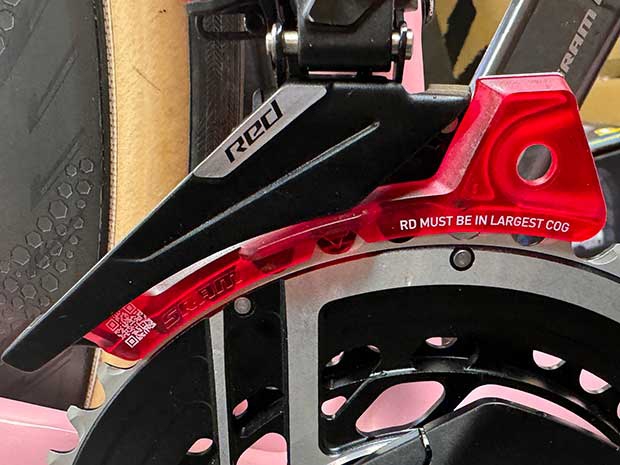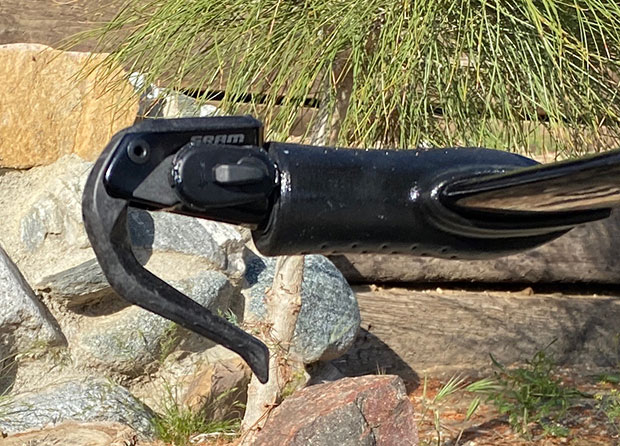SRAM’s New RED Solved Front Shifting. How?

In May SRAM launched its new RED groupset. Touted improvements were weight (150g lighter than old RED), hood comfort, available (low) gearing, better braking and a few other options triathletes will like, such as a 160mm crank length.
But what shouted out to me – acknowledging the points above – was front derailleur performance. SRAM’s front shifting has historically been a subject of discussion and not because it was praiseworthy. It has been speculated that SRAM’s successful foray into 1x for MTB and gravel was driven by its inability to match Shimano’s FD performance. If so maybe this was a blessing in disguise because, now, SRAM is the master of 1x while finally cracking the code on front shifting.
SRAM has gotten so good at 1x many frame makers redesigned around SRAM’s UDH standard for RD attachment. The UDH bypasses the traditional RD hanger, and you mount components like SRAM’s Eagle Transmission RD directly to the frame (no hanger, no limit screws). SRAM’s Transmission and XPLR platforms are remaking 1x and I could imagine all frame makers – road included – driven by SRAM’s rear derailleur schema.

But for road, tri and a lot of gravel it’s still a 2x world and SRAM to be competitive had to bridge up to Shimano’s lead in FD shift performance. New RED solved FD shifting and in fact I’m more impressed with SRAM RED’s FD shifting than it’s RD shifting. I got out my reading glasses, calipers and micrometers and commenced an inspection of this new FD, comparing it to versus previous FDs SRAM has made, to see if I could figure this new one out.
The first thing you notice is the new FD cage is narrower than on old RED and current Force and there is automatic trim, which is new to SRAM. (Automatic trim is an electronic thing; the FD moves toward and away from the frame as the chain moves across the cogset and it does this without you doing anything.) SRAM had relied on what it calls its Yaw technology and this refers to the (nonlinear) path the front derailleur takes when it shifts. I don’t know this but I suspect Yaw – with these no-trim, wider cage derailleurs – were patent workarounds. This new RD keeps its Yaw function but – just my observation – I think the narrower cage is critical to performance but narrow doesn’t work unless you can trim the FD.
If my instinct is correct then the breakthrough in FD shift speed and precision is the redesigned cage and the key that unlocks it is the addition of trim. Did something come off patent allowing SRAM to design a derailleur it was precluded from making before? I don’t know; I asked SRAM and SRAM isn’t telling me. As I hunt around I see Shimano’s patent here that might describe trim in an electronic system. But this patent doesn’t expire until 2027 so, unless Shimano sold and SRAM bought a license (unlikely), I’m barking up the wrong tree.

SRAM has a patent filed in 2016 describing a sensor that picks up changes in the orientation of the rear derailleur pulleys. Those changes cause “the component to perform the action in response to the determination that there is a newly engaged gear.” Could that action be FD trim? Is the input that SRAM uses to trigger a change in FD position different than Shimano’s input and if so could that be the way SRAM avoids infringing? That seems unlikely because if it did then the trim in the FD requires the sensor in the RED RD. But SRAM says, “that trim will happen if [the RED FD] is paired with a Force or Rival AXS system. So, I don’t know. I’m out of my depth here. I believe I know why the shifting is so good; I just can’t navigate the IP that led us here.
There are 3 trim positions. These trims occur when the RD shifts from the 2nd to the 3rd cogs and then again on shifts from the 8th to the 9th cog, and the trim happens at the same places when you shift down the cogset. As well as I can tell the move is about 1.5mm in/outboard during each trim.

There is no difference in the motors between new and old RED; the breakthrough in performance is all due to cage design and cage narrowness. It's also much easier now to set up new RED correctly. The old set-up tool SRAM gave to owners was unintuitive and head scratching. If you tried to hang any SRAM FD on a frame using your own knowledge of FDs and their set-ups you were destined to fail (old school mechanics had to forget everything they knew about FD set-up and proper chain lengths when working with SRAM). The new set-up tool guiding SRAM RED install and adjustment is intuitive and easy (it's that red plastic doo-hickey you see in a couple of the included images. This alone makes the FD perform better because it’s less likely to set it up wrong (it was very easy to set up any other SRAM FD wrong).
The SRAM RED FD is so precise that I rode several rides before I got around to adjusting the hi/lo limit screws. They’re almost redundant. But they’re there nevertheless and I eventually did adjust these.
Is new RED – the whole groupset – better than Dura Ace? Probably depends on use case. SRAM offers compelling bar end shifting options that I like if tri bike is the use case. RED is also easier to travel with! Otherwise, which is better deserves a separate discussion. SRAM’s FD function upgrade will have to make its way down to Force and Rival before SRAM is Shimano’s equal in front shift performance throughout the entire road lineup. But at the RED level SRAM has solved FD shifting – it is now Shimano’s equal – and you can observe and measure why that is.
Now that I’ve got this bit between my teeth I’m going to continue to investigate the patent question and this, along with any other comments that anyone would like to make about the front shifting in this new groupset from SRAM, can be discussed on a thread on our Reader Forum.







Start the discussion at forum.slowtwitch.com